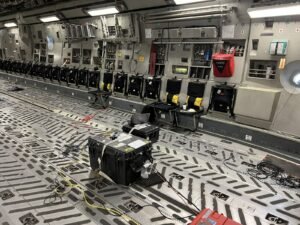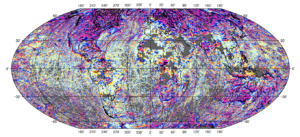In a first for the U.S. Department of Defense, researchers at the Air Force Research Labs (AFRL) and the Massachusetts Institute of Technology (MIT) have successfully demonstrated the capabilities of AI-enhanced magnetic navigation called MagNav.
The cutting-edge technology, which uses variations in the Earth’s magnetic field to navigate, is difficult to jam or spoof, making it a necessary tool for the Air Force. The success of MagNav is potentially the first critical step toward implementing the system across a number of military and civilian platforms, including aircraft, submarines, drones, and even hypersonic glide vehicles.
Magnetic Navigation Less Precise But More Reliable Than GPS
As global positioning systems have become incredibly accurate and effective navigation tools for military and civil aviators alike, pilots have become increasingly dependent on the technology.
This outsized dependence on a single system worries military commanders, who see the GPS network as particularly vulnerable to attack. In fact, this dependence was identified by General Mike Minihan of the Air Mobile Command as one of four critical capability gaps that could be exploited by the country’s adversaries.


Hoping to reduce that dependence on GPS, the AFRL partnered with the folks at MIT and the MIT Lincoln Laboratory to see if combining the concept of magnetic navigation with the advanced machine learning skills of AI was a practical alternative. Their work, which culminated in this first real-time, in-flight test of the concept system they called MagNav, shows that not only is AI-enhanced magnetic navigation possible, but it offers some critical advantages over GPS.
Successful Test Reveals Significant Advantages and Limited Weaknesses of Magnetic Navigation
To test their potentially revolutionary MagNav concept, the AFRL and MIT teams operating under the umbrella of the Artificial Intelligence Accelerator (AIA) installed custom equipment on a C-17A Globemaster III stationed at Travis Air Force Base in California.
According to a press release from the Air Force, the magnetic navigation system “harnessed the power of AI and machine learning through the AIA’s calibration and positioning neural network, which was trained during flight in a matter of minutes on a commercially-available laptop.”
The ability of the system to learn so quickly is aided by decades of researchers assembling a highly detailed map of the Earth’s magnetic field, providing researchers and engineers with a baseline data set to build their MagNav system. Of course, the Earth’s magnetic field is constantly changing, and the aircraft itself also experiences a wide range of magnetic interference that the system depends on machine learning to separate out the magnetic signal from the noise.


Toward that end, the Air Force notes that MagNav team took advantage of global collaboration through its Magnetic Navigation Open Challenge, which involves contributors from around the world submitting data via its open-source software library. According to the press release, “this collaboration improved the AIA’s neural network architecture that removes magnetic noise generated by the aircraft to derive position by comparison to a known magnetic map.”
Unfortunately, the need to constantly update and augment the magnetic field data to maintain the accuracy of the MagNav system and the magnetic noise the AI has to filter out are noted weaknesses. Also, the system tested on the C-17 was accurate to around one kilometer. This is a significant downgrade from the more accurate GPS, which can get an aircraft to within a few feet of the targeted destination.
Still, the MagNav team notes that for a majority of missions, navigating to within one kilometer is all that is needed before traditional tools like visual navigation or landmark recognition take over and guide the aircraft to its final destination.
Alternatives to GPS Critical to Future Military and Civilian Navigation
Perhaps the most critical advantage of magnetic navigation is the fact that it is virtually impossible to jam or spoof, especially from any significant distance. Also, unlike GPS, the system only relies on the equipment onboard the aircraft and not on things like satellites or communication equipment, both of which can be targeted or jammed.
“Every pilot fears single points of failure,” explained Maj. Kyle McAlpin, AIA MagNav liaison. “Our strategy documents lament the DOD’s over-reliance on GPS, a single point of failure in our ability to navigate precisely.”
Nonetheless, McAlpin pointed out, every flight demands “unassailable positioning and navigation.”
“We can achieve that by augmenting GPS with alternatives like celestial navigation, signals of opportunity, visual navigation, and magnetic navigation,” he concluded. “This week, we took an important step towards making one of those modalities a reality by transitioning MagNav from the minds of MIT and MIT Lincoln Laboratory onto an operational aircraft, blazing the trail for our sister services and expansion to new platforms.”
Christopher Plain is the Head Science Writer at The Debrief as well as a Science Fiction and Fantasy novelist. Follow and connect with him on Twitter, learn about his books at plainfiction.com, or email him directly at christopher@thedebrief.org.

